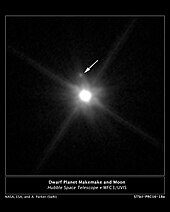S/2015 (136472) 1
 鸟神星和S/2015 (136472) 1 | |
| 发现 | |
|---|---|
| 发现者 | 哈勃望远镜/第三代广域照相机 马克·威廉·布伊等人 |
| 发现日期 | 2015年4月(2016年4月公布) |
| 编号 | |
| 其它名称 | MK 2 (非官方) |
| 轨道参数 | |
| 半长轴 | >21000 km[1] |
| 离心率 | ? |
| 轨道周期 | >12.4 d[1] |
| 轨道倾角 | ? |
| 隶属天体 | 鸟神星 |
| 物理特征 | |
| 大小 | ~ 175 km[1] |
| 质量 | ? |
| 平均密度 | ? |
| 自转周期 | ? |
| 转轴倾角 | ? |
| 反照率 | ~ 0.1 |
| 温度 | ? |
| 视星等 | 25.1 |
S/2015 (136472) 1是柯依伯带矮行星鸟神星已知唯一的卫星,昵称MK 2,尚无正式中文名,按照卫星命名习惯推定正式中文名称将为“鸟卫一”。[2][3]2015年4月,研究人员用哈勃望远镜第三代广域照相机观测到这颗天体,经过数据分析之后,在2016年4月26日通过小行星中心正式宣布这一发现。[4]这颗卫星的发现,使得所有位于海王星轨道外的矮行星都拥有至少一颗卫星。
轨道与特性

此卫星距离鸟神星约13,000英里(21,000千米),估计直径为100英里(160千米),其轨道形状尚不明确。已有的数据显示,若其围绕鸟神星公转轨道为圆形,则其环绕鸟神星一周至少需要12天。[5][6]初步的观测表明它的反照率与木炭类似,是一颗极暗的星体,亮度比鸟神星暗1300倍。鸟神星亮度较高,是柯依伯带中第二亮的星体(仅次于冥王星)。研究人员对二者的亮度反差十分意外。一种理论认为卫星的引力太小,在被太阳照射时难以避免挥发性冰的流失,使得内部的黑暗物质露出。[7][4][5][8]具体结论仍有待继续观测鸟神星及其卫星,以得知卫星的轨道状况,才能进一步了解该卫星的起源。研究人员认为,若其轨道呈圆形,则证明这颗卫星与鸟神星同时形成或是鸟神星被撞击形成;若轨道狭长则证明它是被鸟神星捕获的天体。观测团队指出,无论结论如何,这颗卫星应当在太阳系形成初期就已经形成。[5][9]
观测

此前曾率团队发现过妊神星、鸟神星和阋神星的加州理工学院教授迈克尔·E·布朗一直试图寻找鸟神星的卫星,但没能发现。其他数个鸟神星观测团队也未能发现这颗卫星。美国西南研究院的马克·威廉·布伊率团队通过哈勃望远镜仔细观测后,于2015年4月发现鸟神星附近的一颗亮点,后来经过数据分析后证实为鸟神星的卫星。[2][7]在西南研究院这项研究中主导图像数据分析团队的亚历克斯·帕克(Alex Parker)指出,卫星的轨道似乎以边缘对准地球。这使得它更难被侦测到,因为它经常会被鸟神星的光芒覆盖,再加上它的黑暗表面,使之前的观测都无法发现它。[7]这颗卫星的发现对于鸟神星的研究有巨大帮助,证实鸟神星与冥王星的相似度高于之前的预期,研究人员可以因此了解鸟神星的密度等更多细节。[6][8]
参考资料
- ^ 1.0 1.1 1.2 Parker, Alex H.; Buie, Marc W.; Grundy, Will M.; Noll, Keith S. Discovery of a Makemaken Moon (PDF). 2016 [2016-04-29]. (原始内容 (PDF)存档于2016-06-24).
- ^ 2.0 2.1 Chang, Kenneth. Makemake, the Moonless Dwarf Planet, Has a Moon, After All. New York Times. 2016-04-26 [2016-04-27]. (原始内容存档于2016-04-30).
- ^ 哈勃望远镜惊人新发现:鸟卫一. 中国日报. 2016-04-28 [2016-05-05]. (原始内容存档于2016-05-01).
- ^ 4.0 4.1 Hubble Discovers Moon Orbiting the Dwarf Planet Makemake. HubbleSite. 2016-04-26 [2016-04-27]. (原始内容存档于2019-09-29).
- ^ 5.0 5.1 5.2 Perkins, Sid. Dwarf planet Makemake has a moon. Science. 2016-04-26 [2016-04-27]. doi:10.1126/science.aaf4190. (原始内容存档于2016-04-27).
- ^ 6.0 6.1 Griggs, Mary Beth. HUBBLE SPIES A MOON ORBITING A DISTANT DWARF PLANET. Popular Science. 2016-04-26 [2016-04-27]. (原始内容存档于2016-08-01).
- ^ 7.0 7.1 7.2 Wall, Mike. Distant Dwarf Planet Makemake Has Its Own Moon!. Space.com. 2016-04-26 [2016-04-27]. (原始内容存档于2020-02-02).
- ^ 8.0 8.1 Hubble Discovers Moon Orbiting the Dwarf Planet Makemake. NASA. 2016-04-27 [2016-04-27]. (原始内容存档于2017-08-18).
- ^ Griffiths, James. New moon discovered around dwarf planet Makemake. CNN. 2016-04-27 [2016-04-27]. (原始内容存档于2016-04-28).
| ||||||||||||||||||||||||||||||
Text is available under the CC BY-SA 4.0 license; additional terms may apply.
Images, videos and audio are available under their respective licenses.


